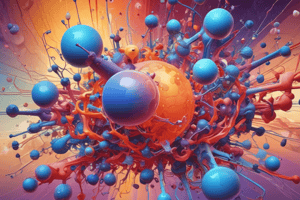Podcast
Questions and Answers
What defines a chemical property?
What defines a chemical property?
- It remains constant regardless of the amount present.
- It is applicable to both pure substances and mixtures.
- It can be observed without changing the substance.
- It can only be observed by changing the identity of the substance. (correct)
Which of the following is an example of an intensive property?
Which of the following is an example of an intensive property?
- Volume
- Mass
- Density (correct)
- Length
Which statement correctly defines extensive properties?
Which statement correctly defines extensive properties?
- Properties that can only be observed at a molecular level.
- Properties that can be transformed into intensive properties.
- Properties that depend on the amount of substance. (correct)
- Properties that remain constant no matter the amount.
How is a pure substance classified?
How is a pure substance classified?
What is a characteristic of a homogeneous mixture?
What is a characteristic of a homogeneous mixture?
Which of the following terms refers to a substance that can be decomposed into simpler components?
Which of the following terms refers to a substance that can be decomposed into simpler components?
Which property describes how a substance can be separated into its components?
Which property describes how a substance can be separated into its components?
In which category does water ($H_2O$) belong?
In which category does water ($H_2O$) belong?
Which property can be observed without changing the identity of the substance?
Which property can be observed without changing the identity of the substance?
What is the boiling point of a substance?
What is the boiling point of a substance?
Which of the following is a measure of how well electric currents move through a substance?
Which of the following is a measure of how well electric currents move through a substance?
What indicates a chemical change in a substance?
What indicates a chemical change in a substance?
What does solubility measure?
What does solubility measure?
Which of the following is classified as a chemical property?
Which of the following is classified as a chemical property?
Which of the following best describes density?
Which of the following best describes density?
Which physical property describes how a material shines or reflects light?
Which physical property describes how a material shines or reflects light?
Which property distinguishes solids from liquids?
Which property distinguishes solids from liquids?
What characterizes particles in gases compared to those in liquids?
What characterizes particles in gases compared to those in liquids?
What happens to particles in a Bose-Einstein Condensate when cooled to absolute zero?
What happens to particles in a Bose-Einstein Condensate when cooled to absolute zero?
Which statement accurately describes plasma?
Which statement accurately describes plasma?
How does the attraction between particles in solids compare to that in gases?
How does the attraction between particles in solids compare to that in gases?
Which characteristic of liquids differs from that of gases?
Which characteristic of liquids differs from that of gases?
What describes the compressibility of solids?
What describes the compressibility of solids?
In which state of matter do particles exhibit random motion in a straight path?
In which state of matter do particles exhibit random motion in a straight path?
Which state of matter has the least particle interaction?
Which state of matter has the least particle interaction?
Which state of matter exhibits the strongest molecular attraction?
Which state of matter exhibits the strongest molecular attraction?
Which state of matter is made up of ionized gases?
Which state of matter is made up of ionized gases?
Which state of matter is stable at very low temperatures, down to -273.15 °C?
Which state of matter is stable at very low temperatures, down to -273.15 °C?
What occurs to solid particles when temperature is increased?
What occurs to solid particles when temperature is increased?
Which of the following statements correctly describes the particle arrangement in gases?
Which of the following statements correctly describes the particle arrangement in gases?
Which state of matter can change shape easily without changing volume?
Which state of matter can change shape easily without changing volume?
What does the term 'particle nature of matter' imply?
What does the term 'particle nature of matter' imply?
What is the purpose of drawing a 1cm line on the filter paper?
What is the purpose of drawing a 1cm line on the filter paper?
What type of samples are used in this chromatography experiment?
What type of samples are used in this chromatography experiment?
Why is it necessary to cover SET A with plastic wrap during the experiment?
Why is it necessary to cover SET A with plastic wrap during the experiment?
How deep should the isopropyl alcohol be poured into the plastic cup?
How deep should the isopropyl alcohol be poured into the plastic cup?
What principle does chromatography rely on when separating mixtures?
What principle does chromatography rely on when separating mixtures?
What is the first step in performing the chromatography experiment?
What is the first step in performing the chromatography experiment?
What outcome is expected after observing the chromatography experiment for 5-10 minutes?
What outcome is expected after observing the chromatography experiment for 5-10 minutes?
What material is used to hold the filter paper vertically during the chromatography process?
What material is used to hold the filter paper vertically during the chromatography process?
Flashcards are hidden until you start studying
Study Notes
States of Matter
- Matter occupies space and has mass; it consists of particles, primarily atoms.
- There are four common states of matter: solid, liquid, gas, and two additional ones: plasma and Bose-Einstein condensate.
- Solid: Definite shape and volume, particles closely packed, strong attraction, incompressible.
- Liquid: No definite shape but has a definite volume, particles can slide past each other, strong attraction.
- Gas: No definite shape or volume, large spaces between particles, fast random motion, compressible.
- Plasma: Ionized gas, very high temperature, occurs in stars and lightning, considered the most common state of matter in the universe.
- Bose-Einstein Condensate: Created at temperatures close to absolute zero, particles behave as a single quantum entity.
Properties of Matter
- Physical Properties: Observable characteristics without changing the identity of the substance.
- Examples: electrical conductivity, thermal conductivity, density, solubility, malleability, magnetic attraction, melting point, luster, boiling point.
- Chemical Properties: Indicates how a substance can change into a new substance.
- Examples: flammability, reactivity, changes in color or odor.
Intensive and Extensive Properties
- Intensive Properties: Do not depend on the amount of substance; examples include density and melting point.
- Extensive Properties: Depend on the amount of substance; examples include mass, volume, length, and number of moles.
Classification of Matter
- Matter can be classified into pure substances and mixtures.
- Pure Substances: Have a definite composition and properties.
- Elements: Cannot be decomposed, consist of one type of atom (e.g., hydrogen, carbon).
- Compounds: Composed of two or more types of atoms combined chemically (e.g., water, carbon dioxide).
- Mixtures: Combinations of two or more substances.
- Homogeneous Mixtures: Uniform in appearance, only one phase (e.g., solutions).
- Heterogeneous Mixtures: Contain two or more phases and can be separated by physical means (e.g., sand and salt).
Laboratory Activity: Paper Chromatography
- Objective: To determine if inks are pure substances or mixtures through chromatography.
- Materials: Filter paper strips, plastic cups, various colored inks, ruler, isopropyl alcohol, etc.
- Procedure: Draw a line on filter paper, apply ink, immerse paper in solvent, and observe separation over time.
- Expected Outputs: Document results with photos and a written procedure.
Key Concepts
- Particle interactions and arrangements vary across different states of matter and affect their properties.
- Understanding physical vs. chemical properties is crucial for identifying substances.
- Intensive and extensive properties provide insights into how substances respond to environmental changes.
Studying That Suits You
Use AI to generate personalized quizzes and flashcards to suit your learning preferences.




